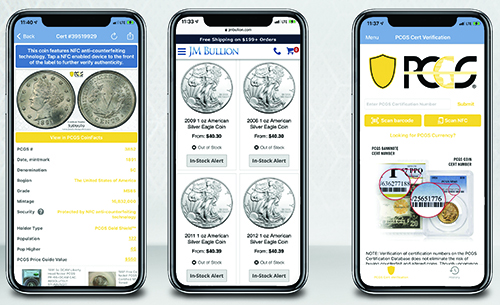
By Joshua McMorrow-Hernandez
The new digital and information age has arrived in numismatics. More than ever before, collectors and dealers depend on computers, tablets, and smartphones to connect with each other and the hobby they love.
The hobby, analog as it is, has long had flirtations with digital technology. Dealers began exchanging bids with each other via teletype machines in the years after World War II. In the late 1980s, an early commercial form of the internet helped deep-pocketed investors trade third-party graded coins sight unseen during the heyday of a particularly robust coin market boom.
By the time the Information Superhighway cut its path into homes from coast to coast during the 1990s, the most tech-savvy dealers were already talking shop in chatrooms while collectors shared knowledge on obscure varieties and a thousand other numismatic things via message boards.
But with the introduction of the smartphone in the early 21st century, collectors could take their hobby virtually anywhere – something that perhaps even coins themselves can’t claim as fewer and fewer people carry physical money with them anymore.
So what is leading this change? How has the internet helped enhance our hobby, and what might the future hold?
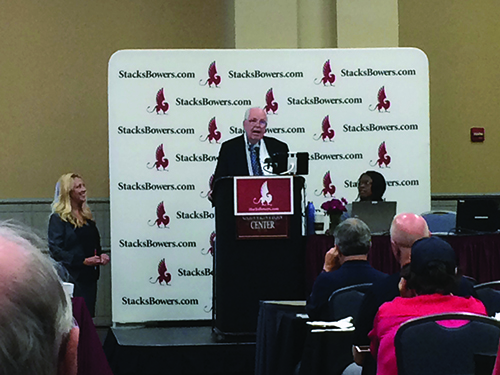
COMPUTERS, TABLETS, AND SMARTPHONES
It’s a brave new world. And it can take a little courage to embrace it, especially when so many coin collectors grew up at a time when all one needed to enjoy numismatics were a few coin folders, a couple books, a trusty loupe, and the camaraderie found at the local coin club. But those days are now little more than distant memories.
Looking back, it’s not all that hard to trace how the evolution between the coin hobby of the 1960s or 1970s unfolded to the point at which we find ourselves with the hobby today. The ever-increasing dangers of counterfeits and alterations inspired the creation of third-party coin grading companies in the mid-1980s, with Professional Coin Grading Service the first to offer grading and encapsulation at scale in 1986 and other companies offering similar services to follow suit in the years afterward.
With third-party grading, sight-unseen buying and selling of numismatic rarities became the norm. This fed perfectly into the online-based ecommerce sector that began driving general retail during the 1990s – a decade that saw the rise of auction houses taking their sales events to the digital realm. Other virtual platforms began giving collectors and dealers an online voice, which they found on numerous chatroom and discussion sites.
The rise of the home computer industry in the late 1970s and early ‘80s helped lower the cost of owning personal computers, ensuring that tens of millions of Americans had digital portals in their homes by the end of the 20th century.
Yet by the turn of the 21st century, people were no longer tied to their in-home computers. Advances in microtechnology made owning portable laptops cheaper in the 1990s. And this led to the creation of even smaller tablets and increasingly powerful cellular phones, the latter able to do so much more than simply place and receive calls, by the 2000s.
Even while many in the coin hobby largely remained absent from the digital scene during the 1990s and early 2000s, it was becoming increasingly difficult to avoid the new technology. Coin dealers realized the benefit of online technology and were creating interactive ecommerce portals to buy and sell coins over the internet. Third-party coin grading services also built online presences to make the submission of coins for authentication and grading easier, as well as to offer a host of other educational resources.
The internet also gave collectors a new opportunity not only to consume content but also to create it. They could do much more than simply post questions and answers in discussion boards. The evolution of the blogosphere in the early 2000s meant that, suddenly, every collector and dealer who felt inclined to write articles could do so. The potential audience? Virtually unlimited.
Then came the mid-2000s, and something new was invented that suddenly gave an entirely new meaning to the word “community” – social media.
Myspace was among the very first of the popular social media sites in 2003, but it would soon be overtaken by an online hub invented by Harvard University student Mark Zuckerburg. His forum, Facebook, became one of the fastest-growing social media sites on the internet, with more than one billion people joining the platform in its first decade of operation.
Unlike many other social media platforms, Facebook had the captivating power to lure people of every age and demographic, and it thus proved instrumental in bringing coin collectors together in an online medium. Today, Facebook is one of the most important online tools collectors use to share information about the hobby and to engage with each other in trades, plans for club meetings, and simply to enjoy some good “old-fashioned” digital discourse – like they would have back in the days of chatrooms in the oh-so-distant 1990s.
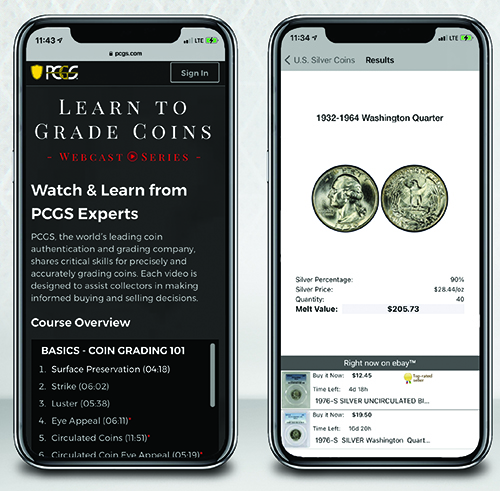
SHARING IS CARING
In social media parlance, to “like” something means you’re acknowledging the post, to “upvote” a comment suggests an endorsement of the ideas presented within. And to “share” something? Well, that’s what all makers of posts and social media content hope you do. Sharing content is how it becomes viral. And for a hobby that could greatly stand to benefit from going viral, sharing is one of the very best things any social media user can do with numismatic content.
While numismatics has a presence on photo-sharing medium Instragram, thought-sharing platform Twitter, and even on video-sharing venue TikTok, Facebook is indisputably the social media destination of choice for coin collectors who want to share their love of the hobby with the world. There are hundreds of coin clubs large and small that use Facebook for interactions with their members. And one of the great things about Facebook is that many of the numismatic-related groups found there exist only because this social media platform gave them a place to live.
One of the many popular hobby groups on Facebook is “Coin Collecting Buy Sell Trade Ask,” which presently has over 16,000 members and is growing fast. It’s a forum where members can pose questions about their coins, answer posts published by others, and engage in buying and selling activity.
“Groups like this one let you explore the vast realms of coins that are out in the world!” says member Gabriel Prince. “It’s fun to see different coins and even get involved with discussions about them. You could even buy or sell them for others to enjoy the coins they like. Everyone has different opinions and tastes of what kind of coin they like. Do what makes you happy, get the one you want!”
John Zieman of Z-Man’s Coins Coin Club on Facebook says the COVID-19 pandemic may have helped expedite the trajectory of increasing dependence the hobby had been placing on digital technology over the past years. “I found that the internet has become a growing resource for coin collecting, research, buying, and selling,” says Zieman. His Facebook group is predicated upon connecting collectors, dealers, and industry professionals, who help each other learn, teach, and show coins and related items so all can enjoy the hobby.
“With COVID-19, I think it has pushed the importance of technology in our hobby ahead of where it would have been. People still love coins, and others make a living buying and selling. With the lack of coin shows, the importance of the internet is evident with the traffic increases. Our Facebook group, Z-Man’s Coins Coin Club, which was started over four years ago, has seen a jump in subscribers and traffic,” Zieman remarks.
“Keeping tabs [of my coin club] on Facebook has helped me as far as getting news and comments from other members,” says Carol Young of the Pawcatuck Valley Coin Club in Rhode Island. “I feel we are so isolated by not being able to meet or visit in person. Some of the dealers I have as friends have helped me with questions.”
Young says several of the Facebook tools have benefits that help her and her fellow coin club members in ways that go well beyond the scope of their function within the numismatic confines of her club. “The personal message app on Facebook lets me call those friends to get clarification. It’s a free app and very useful. I discovered it when, in 2015, my daughter was traveling abroad. No long-distance charges and you can see the person you are calling. I started using it then and continue using it today.”
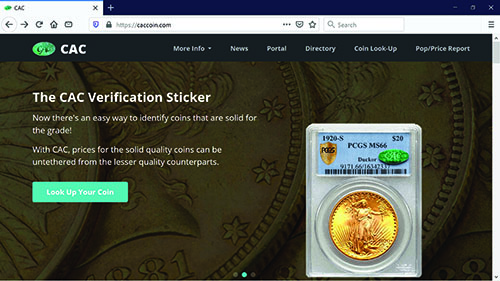
THERE’S AN APP FOR THAT
Many folks who use Facebook access it directly from their smartphones via the tap of an app. And apps are really where it’s at these days. Apps, short for “applications,” are programs that can be installed on your smartphone, tablet, or computer and allow for easy access to a host of digital tools and resources. Most require online access via Wi-Fi connection for full functionality, but they offer enhanced services that you may not find on a website.
One of the leading innovators of numismatic apps is Professional Coin Grading Service (PCGS), a third-party coin-grading service that has been publishing educational resources for the hobby since its inception in the mid-1980s. PCGS went online in 1996 and rapidly built out its array of online offerings to include its PCGS CoinFacts (www.PCGS.com/CoinFacts), which serves as a massive online encyclopedia and coin price guide covering every area of United States coinage as well as world coins and other material.
It’s the type of living project that is built with countless hours of constant involvement by coin experts and subject-area specialists, pricing gurus, and web developers. And it’s unlike anything else the hobby offers. “Since 1986, PCGS has been a pioneer in the numismatic hobby by looking ahead and anticipating what collectors both need and want,” says PCGS president Brett Charville.
“At PCGS, our mission is to serve collectors, dealers, and all involved in our hobby by providing them with the latest and most comprehensive numismatic resources. So we dedicate much of our research and development bandwidth toward creating and testing new digital tools and further upgrading the ones we already offer.”
PCGS offers a series of apps designed to bring a wealth of information and resources right to the fingertips of smartphone-enabled users. Among these apps are PCGS CoinFacts, a free download that delivers all of the information, price charts, and expert insight for each United States coin in the vast PCGS CoinFacts catalog right to your smartphone.
PCGS Cert Verification is another free app that allows collectors and dealers to ensure that the coin they see in a PCGS holder is indeed the one represented on the holder’s label. This is an especially useful tool in an era when counterfeits are becoming more sophisticated. The value of this app was greatly enhanced when PCGS unveiled Near-Field Communications (NFC) chips in all its holders last year. These anti-counterfeiting devices are sealed into new PCGS holders and, when gently tapped with a smartphone, provide all the pertinent information about the coin inside the holder.
Meanwhile, the free PCGS Coinflation app offers the latest bullion prices and spot pricing for all United States coins, including gold, silver, and base-metal coinage. The app offers users the convenience of totaling up spot values for any number of coins in their holdings to gain a better sense of what their collections are worth from the perspective of bullion values.
These apps, along with the PCGS Message Board (https://www.PCGS.com/MessageBoards), have recorded massive numbers of new users since the rise of the COVID-19 pandemic in early 2020 forced cancellations of coin shows and club meetings. Like all digital numismatic mediums, the PCGS apps, message board, and other virtual platforms have provided collectors and dealers with ways to stay connected with each other even in a time when “social distancing” is among the many recommended safety protocols.
“Over the last year, we’ve seen that many collectors have taken their hobby online to stay connected with each other through digital platforms,” Charville said. “But we had already built the foundation for this digital revolution in our hobby by taking the PCGS Set Registry online in 2001, unveiling PCGS CoinFacts in 2009, and last year rolling out NFC devices in all of our holders. And we’ve got a lot of exciting things we’re working on now and look forward to unveiling in the months ahead.”
Another major player on the third-party coin grading scene that has parlayed digital media to serve and educate the numismatic public is Certified Acceptance Corporation (CAC), which was founded by John Albanese in 2007. CAC verifies the grades of coins already certified by PCGS and Numismatic Guaranty Corporation (NGC); qualifying certified coins that are high end or solid for their labeled grades receive green, bean-shaped CAC stickers on their plastic PCGS or NGC holders.
CAC (https://www.caccoin.com/) offers a certification verification portal (https://www.caccoin.com/lookup/) for collectors and dealers to corroborate their certified and CAC-verified holders with those that exist in the CAC database. Meanwhile, those who wish to determine the current population of their CAC coins and the corresponding values can refer to the CAC Population Report and Price Guide (https://www.caccoin.com/pop/).
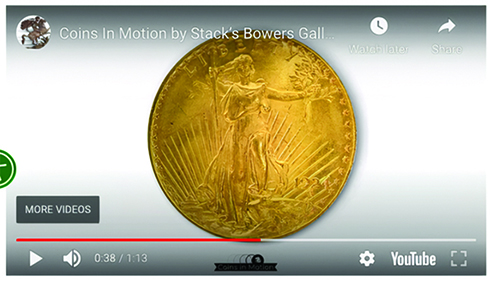
BIDDING ANEW
Auctions have long been a staple in the numismatic marketplace, but until recent years they were mainly conducted in front of large rooms of spectators. Those wanting to buy the lots as they crossed the block had to raise paddles to bid. The scene could get quite intense when bidding wars ensued. But the action had to be done in person. Thus, collectors and dealers had to physically attend the auctions to make their bids or send in qualified proxies who could do the bidding for them.
In recent decades, bidding by telephone became more common. But reaching out and touching some auctions has become even easier with the advent of the internet. And it’s not just eBay where online bidding rules. Traditional auction houses have taken to the internet to host full-scale auctions online. Many virtual auctions have a live floor-bidding component that, along with incoming phone bids, provides at least three ways for bidders to get in on the action.
One of the most innovative online bidding tools is the iBid Live system offered by Stack’s Bowers Galleries to conduct its virtual sales events. “Stack’s Bowers Galleries iBid Live system has received rave reviews from our clients since its inception,” said Stack’s Bowers Galleries Executive Vice President Christine Karstedt.
“It allows our clients to bid live anywhere in the world, on their computer at www.StacksBowers.com, or by using our iOS or Android apps on their mobile device or tablet. We also have the capability to simulcast auctions both within the United States, as well as between the U.S. and Hong Kong, with supplemental bidding rooms in addition to the online auction room.”
Even throughout the height of the pandemic, Stack’s Bowers Galleries continued its offerings by holding auctions in a totally safe and secure online environment.
“During this COVID-19 pandemic, our auction participation has not missed a beat,” Karstedt said. “Our dynamic auction archives along with our superb online photos, catalog descriptions, and pricing information provide everything a collector needs to choose items for purchase and place bids.”
She added that other technological innovations have also helped Stack’s Bowers Galleries provide engaging and comprehensive auction experiences to bidders right in the comfort and safety of their own homes.
“The launch of our latest Coins in Motion ultra-high-resolution animations also enhances our customer experience. And we were recently honored by receiving the Best Dealer Website Award from the Numismatic Literary Guild. I personally invite you to give it a try and let me know what you think.”
Online bidding has certainly helped the consignors wishing to sell million-dollar trophy coins. Even during the pandemic-ridden year of 2020, when most auction bidders stayed close to home, Stack’s Bowers Galleries sold a number of seven-figure coins in auctions that were mostly – or even all but entirely – offered online. Among the top coins sold by Stack’s Bowers Galleries in 2020 were an 1885 Trade dollar graded by PCGS as Proof-64 that sold for $1,320,000, an 1854-S Liberty Head half eagle graded PCGS About Uncirculated 58+ that fetched $1,920,000, and an 1804 Draped Bust dollar graded PCGS Proof-65 that realized a whopping $3,360,000.
LOOKING AHEAD
There’s no going back. The coin hobby will not return to the analog times of yesteryear, when the internet was a novel distraction for teenagers and self-proclaimed computer “geeks.” The future of the hobby is largely tied to the continuing evolution of digital technology, just as the very concept of money is itself. Transactions ranging from buying the morning cup of coffee to one’s next car or house are completed by exchanging monies via digital networks. Meanwhile, investors are continually gravitating toward investments in cryptocurrencies such as Bitcoin.
Appetites for certain investment vehicles are sure to change in the years ahead, but what will remain paramount to all daily dealings is the critical role that digital mediums play in making those transactions happen. And digital technology will only become faster, smaller, and more intuitive than perhaps we can even dream today.
“Each time you toss out a ‘singing’ greeting card, you are disposing of more computing power than existed in the entire world before 1950,” famously said Paul Saffo, consulting professor at the School of Engineering at Stanford University. The onboard computer that helped guide Apollo 11 to the moon in 1969 performed tasks at the same level a standard Commodore 64 home computer could in the early 1980s. And in 1995, most internet service providers offered only dial-up service capped at data speeds of just 56 kilobytes per second; at that rate, it would take more than a week to download the average movie.
What does that mean for where technology is taking us next? We could expect to see digital platforms become even more ubiquitous in our hobby. And maybe we only have to look to the movies of the past to see where this technology is taking us in the future.
Comic book police detective “Dick Tracy” was wearing a two-way radio and television wristwatch in the 1960s that many argue constitutes a fictional prototype of the Apple Watch. A live-action portrayal of videophone communications was originally popularized in the 1968 science-fiction blockbuster 2001: A Space Odyssey. Interacting, three-dimensional hologram projections of human figures play an important role in the Star Wars trilogy of the late 1970s and early 1980s. Time travel by way of a technologically enhanced 1981 Delorean is central to the plot of Back to the Future in 1985.
We’re already talking to each other by video chat. Maybe in a few years you’ll be able to beam a hologram of yourself over to a coin show or travel back in time and buy a new roll of 1909-S VDB Lincoln cents from the bank for 50 cents.












